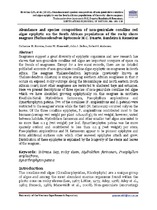| dc.contributor.author | Browne, Catherine M. | |
| dc.contributor.author | Maneveldt, Gavin | |
| dc.contributor.author | Bolton, John J. | |
| dc.contributor.author | Anderson, Robert J. | |
| dc.date.accessioned | 2014-01-30T14:17:43Z | |
| dc.date.available | 2014-01-30T14:17:43Z | |
| dc.date.issued | 2013 | |
| dc.identifier.citation | Browne, C.M., et al. (2013). Abundance and species composition of non-geniculate coralline red algae epiphytic on the South African populations of the rocky shore seagrass Thalassodendron leptocaule M.C. Duarte, Bandeira & Romeiras. South African Journal of Botany, 86: 101-110 | en_US |
| dc.identifier.issn | 0254-6299 | |
| dc.identifier.uri | http://hdl.handle.net/10566/985 | |
| dc.description.abstract | Seagrasses support a great diversity of epiphytic organisms and new research has
shown that non-geniculate coralline red algae are important occupiers of space on
the fronds of seagrasses. Except for a few scant records, there are no detailed
published accounts of non-geniculate coralline algae epiphytic on seagrasses in South
Africa. The seagrass Thalassodendron leptocaule (previously known as
Thalassodendron ciliatum) is unique among southern African seagrasses in that it
occurs on exposed rocky outcrops along the Mozambique and north eastern South
African coast; most other seagrasses are restricted to sheltered bays and estuaries.
Here we present descriptions of three species of non-geniculate coralline red algae
which we have identified growing epiphytically on this seagrass in northern
KwaZulu-Natal: Hydrolithon farinosum, Pneophyllum amplexifrons and
Synarthrophyton patena. Two of the corallines (P. amplexifrons and S. patena) were
restricted to the seagrass' stems while the third (H. farinosum) occurred only on the
leaves. Of the three coralline epiphytes, P. amplexifrons contributed most to the
biomass (average wet weight per plant 0.6±1.18 g); its wet weight, however, varied
between habitats. Hydrolithon farinosum and other smaller turf algae amounted to
no more than 0.1 g (wet weight) per leaf. Synarthrophyton patena was far more
sparsely evident and contributed to less than 0.1 g (wet weight) per stem.
Pneophyllum amplexifrons and H. farinosum appear to be pioneer epiphytes and
form additional surfaces onto which other seaweed epiphytes attach and grow.
Distribution of these epiphytes is explained by the longevity of the stems and leaves
of the seagrass. | en_US |
| dc.language.iso | en | en_US |
| dc.publisher | Elsevier | en_US |
| dc.rights | This is the author postprint version of an article published by Elsevier. | |
| dc.source.uri | http://dx.doi.org/10.1016/j.sajb.2013.02.173 | |
| dc.subject | Sodwana Bay | en_US |
| dc.subject | Rocky shore | en_US |
| dc.subject | Hydrolithon farinosum | en_US |
| dc.subject | Pneophyllum amplexifrons | en_US |
| dc.subject | Synarthrophyton patena | en_US |
| dc.title | Abundance and species composition of non-geniculate coralline red algae epiphytic on the South African populations of the rocky shore seagrass Thalassodendron leptocaule M.C. Duarte, Bandeira & Romeiras | en_US |
| dc.type | Article | en_US |
| dc.privacy.showsubmitter | false | |
| dc.status.ispeerreviewed | true | |
| dc.description.accreditation | Web of Science | en_US |

